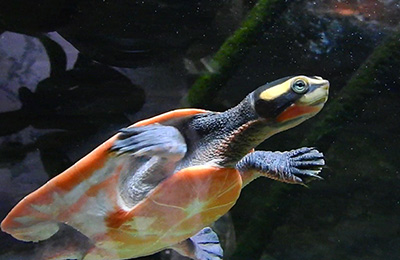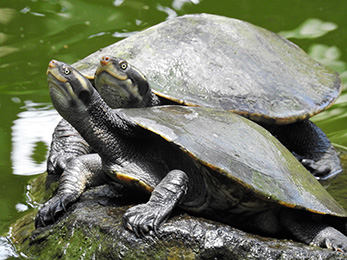FRESHWATER TURTLES
Freshwater Turtles of Australia: Guardians of the Waterways
Australia’s freshwater turtles are ancient survivors, with ancestors that shared the land with dinosaurs. Today, they continue to glide quietly through rivers, lakes, billabongs, and wetlands across the continent, playing an essential role in keeping these ecosystems healthy.
A Life Shaped by Water
Freshwater turtles are perfectly adapted to life in aquatic environments. Their streamlined shells act like natural armour that also allows them to move smoothly through the water, while their webbed feet provide powerful propulsion for swimming.
If you watch closely, you might see one surface briefly to take a deep breath of air before diving back down—sometimes remaining underwater for surprising lengths of time. Some species, like the Mary River Turtle, are famous for their remarkable ability to extract oxygen through specialised areas of skin, including the cloaca, a feature that allows them to stay submerged far longer than most people imagine.
Omnivores with an Important Role
Freshwater turtles are opportunistic omnivores, feeding on:
- Aquatic plants
- Insects and larvae
- Small fish
- Carrion (dead animals)
In doing so, they help to:
- Keep aquatic insect populations under control.
- Recycle nutrients back into the water system.
- Act as nature’s cleaners, preventing the build-up of decaying matter.
This makes turtles not just inhabitants of waterways, but active caretakers of their environment.
The Cycle of Life
Spring and summer bring the breeding season. Female turtles leave the safety of the water to dig sandy or soft nests along the banks, where they carefully deposit their eggs. Weeks later, hatchlings emerge under the cover of night. Their first challenge is daunting—reaching the water while avoiding hungry predators such as birds, goannas, dogs and introduced foxes. Only a small number survive, but those that do may live for 50 years or more.
This perilous start in life reflects the resilience and determination of turtles as a whole—a story of endurance repeated across countless generations.
Challenges and Threats
Despite their adaptability, Australia’s freshwater turtles are under pressure.
| Threat | Impact |
|---|---|
| Habitat destruction | Wetland drainage, river modification, and urban development remove nesting and feeding sites. |
| Pollution | Runoff and plastics damage waterways turtles rely on. |
| Climate change | Rising temperatures affect water flow and the survival of eggs. |
| Invasive species | Foxes, dogs, feral pigs, and introduced fish prey on eggs or compete for food. |
| Illegal poaching | Some turtles are taken for the pet trade, reducing wild populations. |
The Murray River Turtle, Mary River Turtle, and several northern species have already shown alarming population declines, with some considered at risk of extinction.
Protecting Australia’s Turtles
Conservation efforts focus on both protection and education:
- Habitat restoration – Replanting riparian vegetation and restoring natural wetlands.
- Predator management – Controlling introduced species that target eggs and hatchlings.
- Community awareness – Encouraging people to drive carefully near waterways during nesting season and report disturbances.
- Scientific monitoring – Studying nesting sites and turtle populations to guide conservation action.
Why They Matter
Freshwater turtles are not background characters in Australia’s landscapes—they are keystone species that support the balance of aquatic life. Their role as cleaners, grazers, and prey for other animals highlights the subtle web of connections that sustains biodiversity.
When we protect turtles, we protect entire ecosystems.
✅ Takeaway Message
Australia’s freshwater turtles are remarkable survivors from an ancient lineage, but today, they face modern threats that could unravel millions of years of evolution. By valuing their role and taking steps to protect their habitats, we not only preserve these extraordinary reptiles but also safeguard the health of Australia’s rivers and wetlands.






